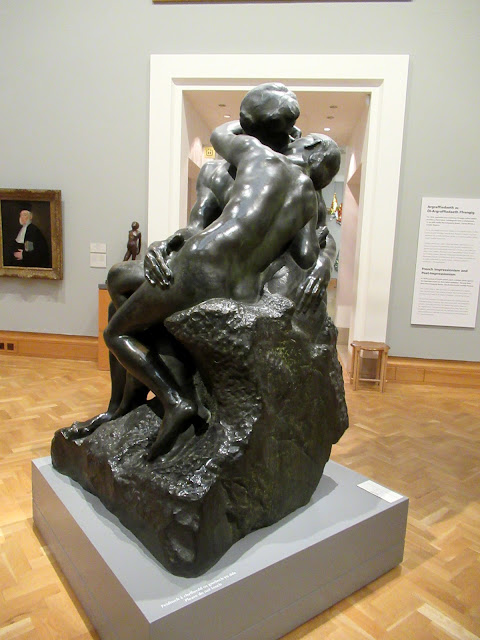Thanks to the Davies sisters Cardiff Museum has a substantial collection of Impressionist and Post-Impressionist paintings. Gwendoline Davies and Margaret Davies amassed one of the great British art collections of the 20th century. Together, they bequeathed 260 works to the National Museum of Wales in 1951 and 1962, completely transforming its art collection in character, quality and range.
Camille Pissarro, Sunset, the Port of Rouen Steamboats, 1898, (oil on canvas)
Camille Pissarro, Pont Neuf, Snow Effect, 2nd series, 1902, (oil on canvas)
The Pont Neuf was one of the busiest bridges in central Paris. The pavements are crowded with people carrying umbrellas while carriages and an early motorcar drive past through the snow. This wintry image is one of 14 painted by Pisarrro of this location. He avoided the problems of working outdoors by renting rooms overlooking the river. This also accounts for the high viewpoint.
Edouard Manet, The Rabbit, 1881, (oil on canvas)
Intended as one of four decorative panels, this work displays a bold, loose style. Completed in the final years of his life, the painting contrasts greatly with Manet's earlier, more conventional compositions of dead game. The work was rejected by the 1882 Salon Exhibition.
Claude Monet, The Thames at London, 1871, (oil on canvas)
Pierre-Auguste Renoir, Young Girl in Blue, 1883, (oil on canvas)
Although this study is unfinished, Renoir's brushwork appears more firmly defined than in earlier works. It was painted at a time when Renoir was reconsidering his technique and looking to works by the Old Masters for inspiration. The bright colours painted onto a white background are, however, still distinctly characteristic of Impressionism.
Edouard Manet, Effects of Snow at Petit-Montrouge, 1870
Edouard Degas, Dressed Dancer, 1879080, (bronze)
Degas wanted the dancer to look as real as possible and dressed the finished version in a linen corset and tutu.
Vincent Van Gogh, Rain, Auvers, 1890, (oil on canvas)
Auguste Rodin, The Kiss, 1887, (bronze)
The lashing rain, vigorous brushwork and contrasting colours express Van Gogh's emotional turmoil at a time of deep personal depression. The wide panoramic format is typical of the group of wheat-field paintings which he produced in June to July 1890, shortly before he shot himself. He wrote to his brother Theo: 'they depict vast, distended wheat fields under angry skies, the I deliberately tried to express sadness and extreme loneliness in them'. The crows circling at the centre seem particularly foreboding.
Auguste Rodin, Eve, 1881-1890s (bronze)
Hiding her face in her arms and cowering in shame, Eve is depicted at the moment that god expressed her from the garden of Eden. Rodin described the difficulty he had sculpting the figure's pelvis. He discovered later that his model was pregnant and felt it added further significance to the subject portrayal.
Claude Monet, The Palazzo Dario, 1908, (oil on canvas)
Claude Monet, San Giorgo Magghiore by Twilight, 1908, (oil on canvas)
Paul Cezanne, Provencal Landscape, 1887-88, (oil on canvas)
Claude Monet, Waterlillies, 1906, (oil on canvas)
Claude Monet, Waterlillies, 1906, (oil on canvas)
'I wanted to make of Impressionism something solid and enduring like the art in museums'.
This simple woodland scene demonstrates Cezanne's complex artistic theories. Contrasting colours and brushstrokes painted in different directions toy with our sense of space and depth. He wanted to create an illusion of form as well as light.
Paul Cezanne, The Francois Zola Dam, 1879, (oil on canvas)





















Wonderful. I enjoyed looking at all the photos and reading the commentary.
ReplyDeleteI really loved that Venetian sunset, Manet's Rabbit, and Pisarro's Parisian bridge.
And I miss Cezanne's patchwork of organey-red grounds. They make for such a strikingly vivid surface that it becomes flower-like in beauty.
Another wonderful post to read. =]
Thank you, Liam. I was particularly pleased with seeing the Van Gogh painting of the rain, probably because I had never seen it before. The Cezanne (Provencal Landscape) was also new to me. It was a good selection of paintings - those sisters had excellent taste, and the funds, of course...
Delete